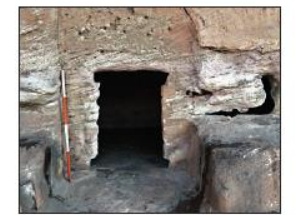Bandhavgarh National Park
This is a collection of articles archived for the excellence of their content. |
Excavations
The findings of 2022
Swati Mathur, Sep 29, 2022: The Times of India

From: Swati Mathur, Sep 29, 2022: The Times of India
New Delhi : After a gap of nearly 85 years, the Archaeological Survey of India has restarted exploration and documentation work of ancient caves, remains of Buddhist structures, temples, and statues of Vishnu Dashavataras in the Bandhavgarh reserve forest area of Madhya Pradesh.
The last time ancient structures were explored in what is now notified as the reserve forest area of Bandhavgarh was in 1938, when the exercise was led by ASI archaeologist N P Chakravarti. Led by Shivakant Bajpayee, the superintending archaeologist of the Jabalpur Circle, ASI’s exploration project between May 20 and June 27 this year found, among other things, names of cities like Mathura and Kaushambi inscribed in Brahmi script, 26 new temples, 46 new sculptures and several monolithic sculptures of Lord Vishnu that have not been documented before, and which are believed to date back to the ninth and tenth century CE.
The exploration of nearly 176 sq km of core forest area that was not accessible to thepublic also led to the discovery of the remains of Buddhist structures predating the Hindu rulers of the region, pointing to a harmony of cultures, the ASI officials said.
Bajpayee said the first phase of the exploration exercise — which covered the entire expanse of the Tala Range of Bandhavgarh — also led the ASI team to find a votive stupa. In phases two and three of the exploration exercise, the ASI team will cover the remaining ranges of the Bandhavgarh forest, spanning the Khitauli and Magadhi ranges.
2023: stupas
Amarjeet Singh1, May 8, 2023: The Times of India

From: Amarjeet Singh1, May 8, 2023: The Times of India
Bhopal : Acouple of days after one-of-a-kind rock art and evidence of a 2,000-year-old ‘modern society’ were discovered in the famed Bandhavgarh tiger reserve in MP’s Umaria district, two Buddhist stupas have been found in the ongoing excavation.
These stupas — one 15fthigh and the other 18ft — were used to contain the ashes of monastic heads. Besides these, Buddhist pillar fragments dating to the 2ndand 3rd centuries, quite similar to the Chaitya pillars of Bedase caves in Maharashtra, have also been found. Last year, in a sensational find, several Buddhist structures were discovered, including a votive stupa.
“The structures found this time are full-fledged Buddhist stupas. These were used by common people and monks alike. These are cylindrical stupas and have all the characteristics of typical Buddhist stupas — like a square platform and hemispheres. Also, one more votive stupa was found this time. From stylistic dating, we estimate these two fledged stupas to be from the 7th or 8th century,” superintending archaeologist, ASI’s Jabalpur circle, Dr ShivakantBajpai told TOI. Bajpai added, “Last year, a votive stupa, a Buddhist pillar and a few Buddhist caves were found, but so far, residential evidence of only rock-cut caves has been found. This area was in the trade route of old times. ”
The written history of Bandhavgarh goes back to at least the 2nd century CE. From the inscription record found from this region, it is clear that it was under the rule of the Magha Dynasty for a very long period of time. After the Magha dynasty, many other dynasties ruled this region.